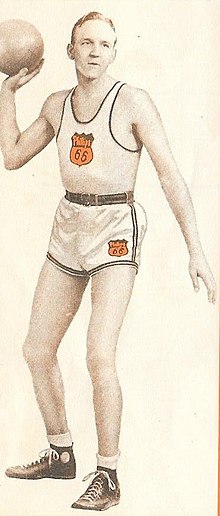Joe Fortenberry
| Joe Fortenberry | ||
| Player information | ||
|---|---|---|
| Full name | Joseph Cephis Fortenberry | |
| Nickname | Big Joe | |
| birthday | April 1, 1911 | |
| place of birth | Slidell , Texas , United States | |
| date of death | 3rd June 1993 | |
| Place of death | Amarillo , Texas , United States | |
| size | 201 cm | |
| position | Center (basketball) | |
| college | West Texas A&M (1929-1932) | |
Joseph "Joe" Cephis Fortenberry (born April 1, 1911 in Slidell , Texas , † June 3, 1993 in Amarillo , Texas) was an American basketball player. He took part in the 1936 Summer Olympics in Berlin and won a gold medal. In the final against Canada, which was won 19: 8, the 2.01 m center advanced to the top scorer.
Career
After graduating from college, he first played for the Ogden Boosters in Utah , later for the McPherson Oilers ( Kansas ) in the NBA's predecessor league : the Amateur Athletic Union (AAU) . With the Oilers he won the championship in 1936. After the Olympic Games, he went basketball for the Phillips 66ers in Bartlesville for five years and won his second championship there in 1940. The native West Texan has been appointed to the AAU All American team four times.
Fortenberry's importance to the sport of basketball derives from the fact that it revolutionized the position of the center player. As one of the most dominant “Big Men” of his era, he acted for the first time in a controlled manner above ring level. His wingspan allowed him to block the throws of his opponents in rows just before the ball reached the basket. Fortenberry's mobility and agility laid the foundation for a generation of similarly working indoor players. In response to this, the goaltending rule was introduced in 1945 .
Fortenberry as the "inventor" of dunking
The first dunk , the direct “stuffing” of the ball into the basket, is often ascribed to Fortenberry. In fact, in the first decades after the invention of basketball, all successful basketball actions were sometimes referred to as dunk ( dipping , dipping ), which is why the concept of dunking as we know it today was seen more as an alternative basket laying variant . Much more, style, aesthetics and timing contributed to the fact that to this day Fortenberry's name remains associated with the spectacular way of closing, as Michael McKnight describes.
“When Joe Fortenberry […] threw one down at the West Side YMCA in New York City on March 9, 1936, he may not have been the first man to dunk a basketball, but he was the first to do it in an aesthetically stirring way, and in front of the right people. Cameras of that era were too crude to capture the split second when the rules of both Newton and Naismith were bent, so it was fortuitous that New York Times writer Arther J. Dayley was at the Y that day covering the tournament that would decide which Americans sailed to Berlin for the Olympic debut of the 45-year-old sport. This new ' version of a layup shot ', Daley wrote, left observers simply flabbergasted. Joe Fortenberry […] left the floor, reached up and pitched the ball downward into the hoop, much like a cafeteria customer dunking a roll in coffee. ”
“When Joe Fortenberry […] stuffed a ball on March 9, 1936 at the West Side YMCA in New York, he may not have been the first man to dunk. But he was the first to do it in an aesthetic, engaging way and watched by the right people. Cameras of the time were not sophisticated enough to capture the exact blink of an eye in which the Newton and Naismith rules were overridden. So it turned out to be a stroke of luck that the New York Times reporter Arthur J. Dayley was in the hall on the day on which a tournament decided which Americans should be sent to Berlin for the Olympic debut of the 45-year-old sport. This new ' version of a lay-up ', said Daley, left observers aghast. Joe Fortenberry [...] took off from the parquet, came upstairs and maneuvered the ball into the ring, like a restaurant visitor who dipped his bun in coffee. "
Fortenberry never claimed to be the inventor of dunking for himself.
Trivia
His gold medal was valued at up to $ 175,000 on the U.S. PBS television program Antiques Roadshow in early 2017.
Individual evidence
- ^ A b Rich Hughes: Netting Out Basketball: 1936 - The Remarkable Story of the McPherson Refiners, the First Team to Dunk, Zone Presse, and Win the Olympic Gold Medal. FriesenPress, Victoria 2011, p. 324.
- ↑ Michael McKnight: Learn to Dunk. In: Rick Telander (Ed.): American Sports Writing 2016. Houghton, Boston / New York 2016, p. 103.
- ↑ amarillo.com
| personal data | |
|---|---|
| SURNAME | Fortenberry, Joe |
| ALTERNATIVE NAMES | Fortenberry, Joseph Cephis (full name) |
| BRIEF DESCRIPTION | American basketball player |
| DATE OF BIRTH | April 1, 1911 |
| PLACE OF BIRTH | Slidell (Texas) |
| DATE OF DEATH | 3rd June 1993 |
| Place of death | Amarillo (Texas) |
